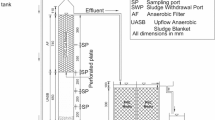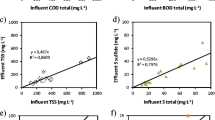Abstract
Anaerobic digestions have been proved more successful than aerobic systems for the degradation and destruction of dye-containing wastewaters. The performance of a hybrid up flow anaerobic sludge-filter bed (UASFB) reactor was tested with a synthetic wastewater containing Crystal violet (CV) as a carbon source and sodium acetate as a co-substrate. Continuous feeding of the reactor started with an initial OLR of 0.9 g COD/l-d and then it was increased step wise to 4 g COD l−1 d−1, while maintaining constant HRT (24 h). The optimum pH value and temperature for decolorization of crystal violet by this mixed culture species under anaerobic conditions were found to be 8–9 and 30–35°C respectively. N,N-dimethylaminophenol and N,N-bis (dimethylamino) benzophenone (Michler’s Ketone) were detected as the degradative metabolites of Crystal Violet. Subsequently, N,N-dimethylaminophenol was further degraded to aniline in the reactor whereas Michler’s ketone was not degraded under anaerobic conditions. The UASFB bioreactor was able to remove the CV completely up to a loading rate of 100 mg CV l−1d−1.






Similar content being viewed by others
References
APHA (2002) Standard methods for the examination of water and wastewater, 20th edn. American Public Health Association, Washington, D.C. USA
Bangert R, Aichele W, Schollmeyer E, Weimann B, Herlinger H (1977) Photooxidation von Malachit grun and Kristall violet. Melliand Textiber 5:399–404
Bumpus JA, Brock J (1988) Biodegradation of crystal violet by the white rot fungus Phanerochaete chrysosporium. Appl Environ Microbiol 54:1143–1150
Carliell CM, Barclay SJ, Shaw C, Wheatley AD, Buckley CA (1998) The effect of salts used in textile dyeing on microbial decolourisation of a reactive azo dye. Environ Technol 19(11):1133–1137
Donlon B, Razo-Flores E, Luijten M, Swarts H, Lettinga H, Fiel JA (1997) Detoxification and partial mineralization of the azo dye mordant orange 1 in a continuous upflow anaerobic sludge blanket reactor. Appl Microbiol Biotechnol 47:83–90
Jhung JK, Choi E (1995) A comparative study of UASB and anaerobic fixed film reactors with development of sludge granulation. Water Res 29:271–277
Pagga U, Brown D (1986) The degradation of dyestuffs: part II behaviour of dyestuffs in aerobic biodegradation tests. Chemosphere 15:479–491
Rajinikanth R, Ramirez I, Steyer JP, Mehrotra I, Kumar P, Escudie R, Torrijos M (2008) Experimental and modeling investigations of a hybrid upflow anaerobic sludge-filter bed (UASFB) reactor. Water Sci Tech 29:271–277
Razo Flores E, Luijten M, Donlon BA, Lettinga G, Field JA (1997) Biodegradation of selected azo dye under methanogenic conditions. Water Sci Technol 36(6–7):65–72
Sarasa J, Roche MP, Ormad MP, Gimeno E, Puig A, Ovelleiro JL (1998) Treatment of a wastewater resulting from dyes manufacturing with ozone and chemical coagulation. Water Res 32(9):2721–2727
Tan NCG, Borger A, Slenders P, Svitelskaya A, Lettinga G, Field JA (2000) Degradation of azo dye mordant yellow 10 in a sequential anaerobic and bioaugmented aerobic bioreactor. Water Sci Technol 42(5–6):337–344
Van der Zee FP, Lettinga G, Field JA (2000) The role of (auto)catalysis in the mechanism of an anaerobic azo reduction. Water Sci Technol 42(5–6):301–308
Van der Zee FP, Lettinga G, Field JA (2001) Azo dye decolourisation by anaerobic granular sludge. Chemosphere 44:1169–1176
Wackett LP (1996) Co-metabolism: is the emperor wearing any clothes? Curr Opin Biotechnol 7:321–325
Acknowledgments
The authors are thankful to the Aligarh Muslim University, Aligarh (India) for providing research facilities and also thankful to the UGC (University Grants Commission) for providing financial assistance to one of the author, Pijush Kanti Mondal.
Author information
Authors and Affiliations
Corresponding author
Rights and permissions
About this article
Cite this article
Mondal, P.K., Ahmad, R. & Usmani, S.Q. Anaerobic biodegradation of triphenylmethane dyes in a hybrid UASFB reactor for wastewater remediation. Biodegradation 21, 1041–1047 (2010). https://doi.org/10.1007/s10532-010-9364-x
Received:
Accepted:
Published:
Issue Date:
DOI: https://doi.org/10.1007/s10532-010-9364-x




